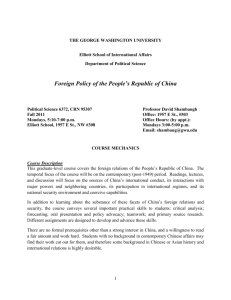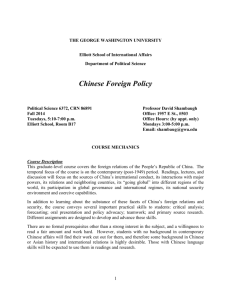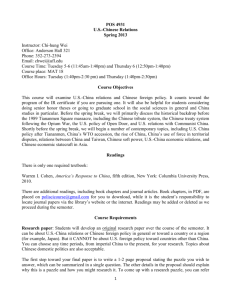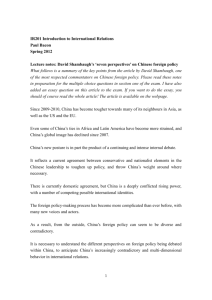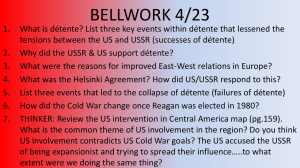syllabus - Department of Political Science
advertisement
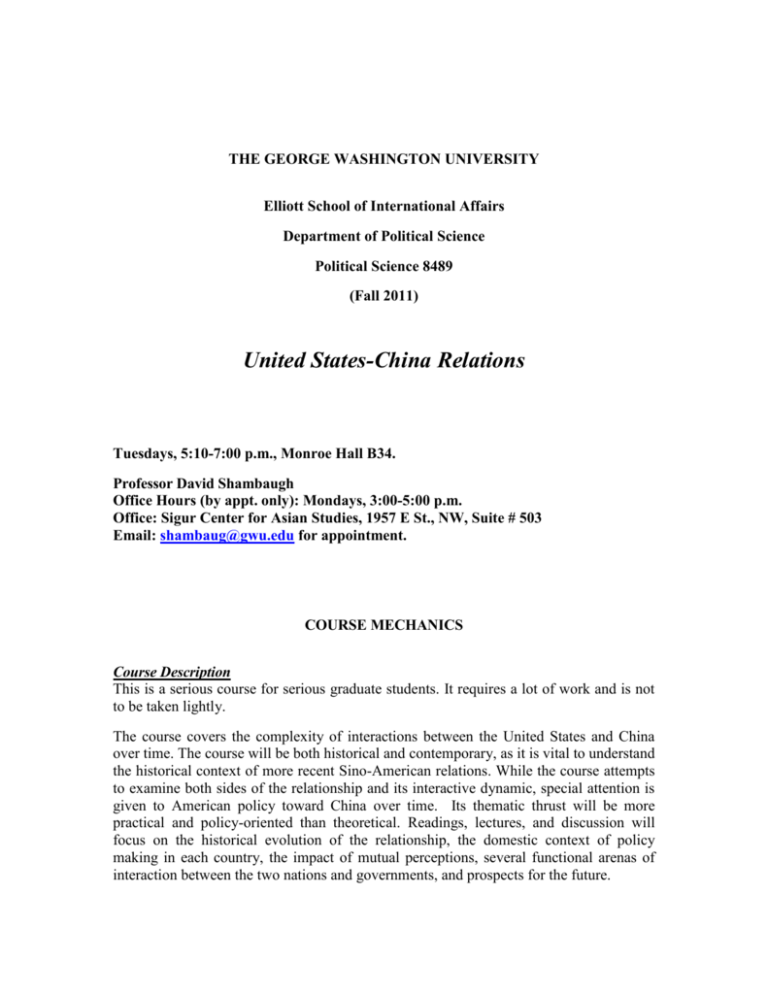
THE GEORGE WASHINGTON UNIVERSITY Elliott School of International Affairs Department of Political Science Political Science 8489 (Fall 2011) United States-China Relations Tuesdays, 5:10-7:00 p.m., Monroe Hall B34. Professor David Shambaugh Office Hours (by appt. only): Mondays, 3:00-5:00 p.m. Office: Sigur Center for Asian Studies, 1957 E St., NW, Suite # 503 Email: shambaug@gwu.edu for appointment. COURSE MECHANICS Course Description This is a serious course for serious graduate students. It requires a lot of work and is not to be taken lightly. The course covers the complexity of interactions between the United States and China over time. The course will be both historical and contemporary, as it is vital to understand the historical context of more recent Sino-American relations. While the course attempts to examine both sides of the relationship and its interactive dynamic, special attention is given to American policy toward China over time. Its thematic thrust will be more practical and policy-oriented than theoretical. Readings, lectures, and discussion will focus on the historical evolution of the relationship, the domestic context of policy making in each country, the impact of mutual perceptions, several functional arenas of interaction between the two nations and governments, and prospects for the future. In addition to learning about the substance of these facets of U.S.-China relations, the course is designed to teach several important practical skills to students: informed reading and critical analysis; oral presentation and policy advocacy; teamwork; forecasting; indepth research; and writing. Different assignments are designed to develop and advance these skills. There are no formal prerequisites for this course other than a strong interest in China and U.S. diplomacy, and a willingness to read a large amount and work hard. Students with background in Chinese affairs, U.S. foreign policy, and the international relations of East Asia will be well-served. COURSE REQUIREMENTS Readings The first course requirement is to do a lot of reading. There is a large and wonderful literature on Sino-American relations. We cannot read even a large fraction of it, but students will be exposed to a number of classic in addition to more recent books in the field, as well as a variety of important articles. Each week there will be one book and often a number of articles assigned. All articles can be accessed via Alladin and JSTOR. There will also be some recommended readings in several areas, for students who wish to read further into a given area of the relationship, and to pursue in their research papers. As these required readings are heavy, if you cannot do it all, read as much as possible. All books are available at the GWU Bookstore or from Amazon, and all (except Friedberg) should be available in paperback). These include: Robert Sutter, U.S.-Chinese Relations: Perilous Past, Pragmatic Present (Lynne Reinner, 2010 edition) T. Christopher Jesperson, American Images of China, 1931-1949 (University of California, 1994). Chen Jian, Mao’s China and the Cold War (University of North Carolina Press, 2000). Robert Suettinger, Beyond Tiananmen: The Politics of U.S.-China Relations, 1989-2000 (Brookings, 2003). Richard Madsen, China in the American Dream: A Moral Inquiry (University of California, 1995) Carola McGiffert and John Hamre (eds.), Chinese Images of the United States (Center for Strategic & International Studies, 2005) Michael Swaine, America’s Challenge: Engaging a Rising China in the Twenty-First Century (Carnegie Endowment, 2011) Aaron Friedberg, A Contest for Supremacy: China, America, and the Struggle for Mastery in Asia (W.W. Norton, 2011) Kevin Pollpeter, U.S.-China Security Management (Rand Corporation, 2004) Zachary Karabell, Superfusion (Simon & Schuster, 2009) James Mann, The China Fantasy (Viking, 2007) Recommended but Not Required: Ramon Myers, Michel Oksenberg, and David Shambaugh (eds.), Making China Policy: Lessons from the Bush and Clinton Administrations (Rowman & Littlefield, 2001) David M. Lampton (ed.), The Making of Chinese Foreign & Security Policy in the Era of Reform (Stanford University Press, 2002). In Addition: Students will find the following surveys of Sino-American Relations very useful: Henry Kissinger, On China Richard Rosecrance and Gu Guoliang (eds.), Power and Restraint: A Shared Vision for the U.S.-China Relationship Scott Kennedy, The American Debate Over China Policy Since Normalization (Roman & Littlefield, 2003) Harry Harding, A Fragile Relationship: The United States and China Since 1972 (Brookings, 1992). James Mann, About Face: A History of America’s Curious Relationship with China, from Nixon to Clinton (Knopf, 1999). Patrick Tyler, A Great Wall: Six Presidents and China (Public Affairs, 1999). Nancy Bernkopf Tucker (ed.), China Confidential: American Diplomats and SinoAmerican Relations, 1945-1996 (Columbia University Press, 2001). In the Classroom Most class sessions will be a combination of lecture and discussion of the topic and readings. An occasional video may be shown, and we might have some guest speakers from the U.S. and Chinese governments. Videos As history is distant, it often develops an abstract quality through prose. Thus, the class will draw on benefit from a series of excellent historical documentaries. Students are responsible for all of this material. Writing Requirements Students will be required to write two papers during the semester—each aimed at developing different skills. The first will be a 12-15 page (double-spaced) essay analyzing historical “Patterns of Interaction in U.S.-China Relations.” It should be based on the readings for the first six weeks of the course and should be thematic in orientation, i.e. to identity the principal variables and patterns in the U.S.-China relationship during the past century. Do not get bogged down in the detail of what happened when, but rather focus on the broad factors that have shaped the relationship over time, factors that have caused breaks in the relationship as well as those producing cooperation. Use historical details to illustrate themes and patterns of interaction. The paper is due in class at Session 7. The second written assignment will be an exercise in forecasting—and will be coupled with oral briefings. It will be related to any ONE of these sessions 9-13 in Part III of the course (“Arenas of Interaction”). Based on the readings for the session you choose, you are to imagine that you are part of a U.S. government-wide drafting team, coordinated by the National Intelligence Council and resulting in a National Intelligence Estimate (NIE), which attempts to forecast: “The United States, China, and XXX: Factors in the Future Evolution of the Relationship.” This paper should also be in the range of 8-10 pages (double-spaced), with an Executive Summary of 300 words, and should forecast 2-3 years into the future how U.S.-China relations will likely transpire in the selected arena and why? This paper will be written by each individual student, but will be tied to team presentations given in the appropriate class. A Bibliography of sources consulted should be attached. A template for the NIE will be distributed in class. This second paper is due in class the day of the presentations. Ph.D.-track students in the Department of Political Science are required to write one additional paper during the semester: a ten-page critical literature review of any single topic on the syllabus (the equivalent of four books on that topic). Students are expected to go beyond the required and recommended readings to deeply explore the subject matter; please consult with the instructor in choosing topic and readings. Note: Violation of the Academic Integrity Code (e.g. plagiarism) can result in failure of the course and university-specified penalties. Other Requirements As teamwork is a prized asset in the workplace today, and is central to many careers in international affairs, there will be one team-based project during the semester. The exercise is tied to Part III of the course, “Arenas of Interaction,” and the second written assignment noted above. Students will divide into one of five equal teams. Each team will present, in about 90 minutes, a briefing on the key aspects and prospects in each arena over the past 2-3 years and for the next 2-3 years into the future. The format will be a simulated briefing of the National Intelligence Council. Students should be prepared to orally explain their team’s predictions and rationale for them. Grading Grades will be comprised of the following components: Two papers (40% x 2) Team-based project presentation (20%) Ph.D. students’ literature critique will count for 20%, while each briefing paper will count for 30%. COURSE SCHEDULE & READINGS I. The Historical Evolution of Sino-American Relations Session 1: The United States and China Prior to 1911 Required: Robert Sutter, U.S.-Chinese Relations: Perilous Past, Pragmatic Present, chapters 1-2. Video: The China Call Highly Recommended: Michael Hunt, The Making of a Special Relationship: The United States and China to 1912 Recommended: Jonathan Spence, To Change China: Western Advisors in China, 1620-1960. _____________, The Search for Modern China, pp. 158-164, 170-184, 216-238. Warren Cohen, America’s Response to China (4th ed.), chapters 1-2. John K. Fairbank, The United States and China (4th ed.), chapter 12. Y.C. Wang, Chinese Intellectuals and the West, 1872-1949 Session 2: The United States and China, 1911-1949 Required: Barbara W. Tuchman, “If Mao Had Come to Washington in 1945: An Essay in Alternatives,” Foreign Affairs (1972), in Barbara W. Tuchman, Notes From China Sutter, U.S.-Chinese Relations, chapter 3. T. Christopher Jesperson, American Images of China, 1931-1949 Video: The Dragon & Eagle Highly Recommended: Barbara Tuchman, Stilwell and the American Experience in China James C. Thomson, While China Faced West: American Reformers in Nationalist China Recommended: John King Fairbank, The United States and China (4th ed.) Patricia Neils (ed.), United States Attitudes and Policies Toward China: The Impact of American Missionaries John Garver, The Sino-American Alliance Michael Schaller, The U.S. Crusade in China, 1938-45 Tang Tsou, America’s Failure in China Yu Maochun, The OSS in China John Stuart Service, Lost Chance in China Department of State, United States Relations with China (1949) and Mao Zedong, On the U.S. White Paper Peter Buck, American Science and Modern China Mary Brown Bullock, An American Transplant Phillip West, Yenching University and Sino-Western Relations Barry Keenan, The Dewey Experiment in China Session 3: The Cold War, 1949-1972 Required: Chen Jian, Mao’s China and the Cold War Video: Cold War (Episode 15) Highly Recommended: Robert S. Ross and Changbin Jiang (eds.), Re-examining the Cold War: U.S.-China Diplomacy, 1954-1973 Recommended: Gordon Chang, Friends and Enemies: The United States, China, and the Soviet Union, 1948-1972. Zhang Shu Guang, Economic Cold War: America’s Embargo Against China and the Sino-Soviet Alliance, 1949-1963 ______________, Deterrence and Strategic Culture: Chinese-American Confrontations, 1949-1958 Roderick MacFarquhar, Sino-American Relations, 1949-1971 William Burr (ed.), The Kissinger Transcripts Thomas Christensen, Useful Adversaries Robert Sutter, China Watch: Toward Sino-American Reconciliation E.J. Kahn Jr., The China Hands Nancy Bernkopf Tucker, Taiwan, Hong Kong, and the United States Chen Jian, China’s Road to the Korean War John W. Lewis, Sergei Goncharov, and Xue Litai, Uncertain Partners: Stalin, Mao, and the Korean War Thomas Christensen, Useful Adversaries: Grand Strategy, Domestic Mobilization, and Sino-American Conflict, 1947-1958 Jan Kallicki, The Pattern of Sino-American Crises Odd Arne Westad, Cold War & Revolution Qiang Zhai, China and the Vietnam Wars, 1950-1975 Lewis Purifoy, Harry Truman’s China Policy Foster Rhea Dulles, American Foreign Policy Toward Communist China, 1949-1969 The Cold War International History Project Bulletin (Issues 6-7) Session 4: After the Opening: Building the Relationship, 1972-1989 Required: Robert Sutter, U.S.-Chinese Relations, chapter 4. Michel Oksenberg, “A Decade of Sino-American Relations,” Foreign Affairs (Fall 1982) Video: History Declassified: Nixon in China Highly Recommended: William Kirby, Robert Ross, Gong Li (eds.), Normalization of U.S.-China Relations: An International History Recommended: Robert Ross, Negotiating Cooperation: The United States and China, 1969-1989 China and the United States: From Hostility to Engagement, 1960-1998 and Tiananmen Square, 1989: The Declassified History. Available at: http://www.gwu.edu/~nsarchiv/ Harry Harding, A Fragile Relationship: The United States and China Since 1972 Michel Oksenberg and Robert Oxnam (eds.), Dragon and Eagle Andrew Nathan and Perry Link (eds.), The Tiananmen Papers James Mann, About Face: A History of America’s Curious Relationship with China, from Nixon to Clinton, relevant chapters. Patrick Tyler, A Great Wall, relevant chapters. Rosemary Foot, The Practice of Power John Holdridge, Crossing the Divide David M. Lampton et al, A Relationship Restored Memoirs of Richard Nixon, Henry Kissinger, Jimmy Carter, Zbigniew Brzezinski, Cyrus Vance, Alexander Haig. Session 5: Difficult Years: From Tiananmen to Terrorism, 1989-2001 Required: Robert Suettinger, Beyond Tiananmen: The Politics of U.S.-China Relations, 1989-2000 Robert Sutter, U.S.-Chinese Relations, chapter 5. Highly Recommended: David M. Lampton, Same Bed, Different Dreams: Managing U.S.-China Relations, 19892000 Ramon Myers, Michel Oksenberg, and David Shambaugh (eds.), Making China Policy: Lessons from the Bush and Clinton Administrations George H.W. Bush, The China Diaries of George H.W. Bush Recommended: James Mann, About Face Harry Harding, A Fragile Relationship National Committee on U.S.-China Relations, United States-China Relations: Current Tensions, Policy Choices Kenneth Lieberthal, “A New China Strategy,” Foreign Affairs (November-December 1995). David M. Lampton, “America’s China Policy in the Age of the Finance Minister: Clinton Ends Linkage,” The China Quarterly (September 1994) David M. Lampton and Alfred Wilhelm (eds.), United States-China Relations at a Crossroads James Shinn (ed.), Weaving the Net: Conditional Engagement with China David Shambaugh, “The United States and China: Cooperation or Confrontation?” Current History (September 1997) _____________, “The U.S. and China: A New Cold War?” Current History (September 1995) Steven Levine, “China and America: The Resilient Relationship,” Current History (September 1992) David Bachman, “The United States and China: Rhetoric and Reality,” Current History (September 2001) Nancy Bernkopf Tucker, “A Precarious Balance: Clinton and China,” Current History (September 1998) David Zweig, “Clinton and China: Creating a Policy Agenda that Works,” Current History (September 1993) Joseph Fewsmith, “America and China: Back From the Brink,” Current History (September 1994) Robert Sutter, “Tiananmen’s Lingering Fallout on Sino-American Relations,” Current History (September 1991) Robert Sutter, “Sino-American Relations in Adversity,” Current History (September 1990) Gideon Rachman, “Containing China,” The Washington Quarterly (Winter 1996) Richard Bernstein and Ross Munro, “The Coming Conflict with America,” Foreign Affairs (March-April 1997) Robert Ross, “Why Our Hardliners are Wrong,” The National Interest (Fall 1997) Session 6: Sino-American Relations During the George W. Bush/Barack Obama and Jiang Zemin/Hu Jintao Eras Required: Robert Sutter, U.S.-Chinese Relations, chapters 6-7. Council on Foreign Relations, U.S.-China Relations: An Affirmative Agenda, available at: http://www.cfr.org/china/us-china-relations/p12985. Highly Recommended: Jonathan D. Pollack (ed.), Strategic Surprise: U.S.-China Relations in the Early 21st Century Recommended: Joseph Nye, “American and Chinese Power After the Financial Crisis,” The Washington Quarterly (October 2010) Thomas Christensen, “Shaping the Choices of a Rising China: Recent Lessons for the Obama Administration,” The Washington Quarterly (July 2009) John W. Garver, “Sino-American Relations in 2001,” International Journal (Spring 2002) David Shambaugh, “Facing Reality in China Policy,” Foreign Affairs (January/February 2001). David Shambaugh, “Sino-American Relations Since September 11: Can the New Stability Last?” Current History (September 2002). David M. Lampton, “Small Mercies: China and America After 9/11,” The National Interest (Winter 2001/02). David M. Lampton, “The Stealth Normalization of U.S.-China Relations,” The National Interest (Fall 2003). Aaron Friedberg, “11 September and the Future of Sino-American Relations,” Survival (Spring 2002). Bonnie Glaser, “U.S.-China Relations,” Comparative Connections (http://www.csis.org/pacfor/cc/), regularly updated. II. Mutual Images and Policy Making Session 7: Mutual Perceptions Required: Richard Madsen, China and the American Dream AND Carola McGiffert and John Hamre, Chinese Images of the United States Highly Recommended: David Shambaugh, Beautiful Imperialist: China Perceives America, 1972-1990 Carola McGiffert and John Hamre (eds.), China in the American Political Imagination Recommended on U.S.: Harold Issacs, Scratches On Our Minds John King Fairbank, China Perceived: Images and Policies in Sino-American Relations Benson Lee Greyson (ed.), The American Image of China Jianwei Wang, Limited Adversaries: Post-Cold War Sino-American Mutual Images National Committee on U.S.-China Relations, U.S. Media Coverage of China Hongshan Li and Zhaohui Hong (eds.), Image, Perception, and the Making of U.S. China Relations David M. Lampton, Same Bed, Different Dreams. Peter Gries, China’s New Nationalism David Shambaugh, “Coping with a Conflicted China,” The Washington Quarterly (Winter 2011). David Shambaugh, “Imagining Demons: The Rise of Negative Imagery in U.S.-China Relations,” Journal of Contemporary China (May 2003). Emma Broomfield, “Perceptions of Danger: The China Threat Theory,” Journal of Contemporary China (May 2003). Alexander Liss, “Images of China in the American Media,” Journal of Contemporary China (May 2003). Stanley Lubman, “The Dragon as Demon: Images of China on Capitol Hill,” Journal of Contemporary China (August 2004) Recommended on China: Biwu Zhang, “Chinese Perceptions of American Power, 1991-2004,” Asian Survey (May 2005) Samantha Blum, “Chinese Views of U.S. Hegemony,” Journal of Contemporary China (May 2003). Rosalie Chen, “China Perceives America,” Journal of Contemporary China (May 2003). Philip Saunders, “China’s America Watchers: Changing Attitudes Toward the United States,” The China Quarterly (March 2000). David Shambaugh, “Anti-Americanism in China,” in Anti-Americanism: Origins and Context,” The Annals of the American Academy of Political and Social Science (May 1988). Wang Jisi, “Beauty and Beast,” Wilson Quarterly (Spring 2001). Michael Pillsbury, “China’s Perceptions of the USA: A View from Open Sources,” available at http://www.uscc.gov/) Ren Yue, “China’s Perceived Image of the United States: Its Sources and Impact,” in Koehn and Cheng (eds.), U.S.-China Relations Following the 1997-1998 Summits Hongshan Li and Zhaohui Hong, Image, Perception, and the Making of U.S.-China Relations, chapters 7-10. Yuan-li Wu, As Peking Sees Us David Arkush and Leo O. Lee, Land Without Ghosts Yong Deng and Fei-ling Wang, In the Eyes of the Dragon: China Views the World Session 8: Domestic Sources of Sino-American Policy Making Required: Ramon Myers, Michel Oksenberg, and David Shambaugh (eds.), Making China Policy: Lessons from the Bush and Clinton Administrations OR David M. Lampton (ed.), The Making of Chinese Foreign & Security Policy in the Era of Reform Recommended on the U.S.: Robert Suettinger, Beyond Tiananmen: The Politics of U.S.-China Relations, 1989-2000 David Lampton, Same Bed, Different Dreams Robert Ross (ed.), After the Cold War: Domestic Factors Affecting U.S.-China Relations Ashton Carter and William J. Perry, The Content of Engagement with China Bates Gill, “Limited Engagement,” Foreign Affairs (July-August 1999) Robert Sutter, The China Quandry: Domestic Determinants of U.S. China Policy, 19721982 Robert Sutter, U.S. Policy Towards China: The Role of Interest Groups Peter H. Koehn and Xiaohuang Yin, The Expanding Roles of Chinese Americans in U.S.China Relations Ezra Vogel, Living with China Robert Zoellick, “What Engagement Means,” The National Interest (Winter 1996-97) Tan Qingshan, The Making of U.S. China Policy Jonathan D. Pollack (ed.), Strategic Surprise Recommended on China: Susan Shirk, Fragile Superpower David Shambaugh, China’s Communist Party: Atrophy & Adaptation Peter Gries, China’s New Nationalism Michael Swaine, China: Domestic Change and Foreign Policy Ezra Vogel (ed.), Living with China Articles by Shambaugh, Glaser/Saunders, and Mulvenon/Gill on Chinese think tanks, The China Quarterly (September 2002) Robert Sutter, Chinese Policy Priorities and Their Implications for the United States David Shambaugh, “Containment or Engagement of China: Calculating Beijing’s Responses,” International Security (Fall 1996) Yong Deng, “The Chinese Conception of National Interests in International Relations,” The China Quarterly (June 1998) Allen S. Whiting, “Chinese Nationalism and Foreign Policy After Deng,” The China Quarterly (June 1995) III. Arenas of Sino-American Interaction Session 9: Multilateral Institutions and Global Governance Required: Rosemary Foot and Andrew Walter, China, the United States and Global Order Michael Swaine, America’s Challenge: Engaging a Rising China in the Twenty-First Century, chapters 3, 7. Elizabeth Economy, “The Game Changer: Coping with China’s Foreign Policy Revolution,” Foreign Affairs (November/December 2010) Highly Recommended: G. John Ikenberry, “The Rise of China and the Future of the West: Can the Liberal Order Survive?” Foreign Affairs (January/February 2008) Michael Fulilove, “China and the United Nations: The Stakeholder Spectrum,” The Washington Quarterly (Summer 2011). Gregory Chin, “Will China Change the Rules of Global Order?” The Washington Quarterly (October 2011). Recommended: Ann Kent, Beyond Compliance Evan Medeiros, China’s International Behavior: Activism, Opportunism, and Diversification Gerald Chan, China’s Compliance in Global Affairs Katherine Morton, China and the Global Environment: Learning from the Past, Anticipating the Future Katherine Morton, Taming the Yellow Dragon: International Aid and China’s Environment Elizabeth Economy, The River Runs Black: The Environmental Challenge to China’s Future Elizabeth Economy and Adam Segal, “The G-2 Mirage,” Foreign Affairs (May/June 2009) Pamela Baldinger and Jennifer Turner, Crouching Suspicions, Hidden Potential Thomas Christensen, “The Advantages of an Assertive China,” Foreign Affairs (March/April 2011) Session 10: The Security and Military Context Required: Michael Swaine, America’s Challenge, chapters 4, 6. Robert Sutter, U.S.-Chinese Relations, chapter 8, 10. Kevin Pollpeter, U.S.-China Security Management: Assessing the Military-Military Relationship Wang Jisi, “China’s Search for a Grand Strategy,” Foreign Affairs (March/April 2011). Highly Recommended: U.S. Department of Defense, Annual Report on the Military Power of the People’s Republic of China (available at: http://www.defenselink.mil/pubs) Recommended: Michael Swaine et al, Managing Sino-American Crises: Case Studies & Analysis Christopher Twomey, The Military Lens Zalmay Khalilzad, The United States and a Rising China: Strategic & Military Implications Council on Foreign Relations Task Force on Chinese Military Power (2003) Denny Roy, “China’s Reaction to American Predominance,” Survival (Autumn 2003). Yong Deng, “Hegemon on the Offensive: Chinese Perceptions on U.S. Global Strategy,” Political Science Quarterly, Vol. 116, No. 3 (2001). Wu Xinbo, “Understanding Chinese and U.S. Crisis Behavior,” The Washington Quarterly (Winter 2008) Herbert Yee and Ian Storey, The China Threat: Perceptions, Myths, and Realities Steven Mosher, Hegemon: China’s Plan to Dominate Asia and the World Ted Galen Carpenter and Robert Dorn, China’s Future: Constructive Partner or Emerging Threat? David M. Lampton and Gregory May, Managing the U.S.-China Relationship in the Twenty-First Century (Nixon Center 2000) Benjamin Self and Jeffrey Thomson (eds.), An Alliance for Engagement: Building Cooperation for Security Relations with China David Shambaugh, “Sino-American Strategic Relations: Partners or Competitors?” Survival (Spring 2000). David Shambaugh, Modernizing China’s Military. David Shambaugh, “China Military Views the World: Ambivalent Security,” International Security (Winter 1999/2000) Dennis Blasko, The Chinese Army Today Thomas Christensen, “China, the U.S.-Japan Alliance, and the Security Dilemma in East Asia,” International Security (Spring 1999) Taylor Fravel, “China’s Search for Military Power,” The Washington Quarterly (Summer 2008) Ezra Vogel (ed.), Living with China, chapter 2. Robert S. MacNamara et al, Sino-American Military Relations National Committee on U.S.-China Relations, United States-China Relations: Comparative Security and Foreign Policy Processes Session 11: The Regional Context Required: Aaron Friedberg, A Contest for Supremacy: China, America, and the Struggle for Mastery in Asia Michael Swaine, America’s Challenge, chapter 2. Hugh White, “Power Shift: Australia’s Future between Washington and Beijing,” in Quarterly Essay, No. 39 (2010) Highly Recommended: Evan S. Medeiros et al, Pacific Currents: The Responses of U.S. Allies and Security Partners in East Asia to China’s Rise David Shambaugh (ed.), Power Shift: China and Asia’s New Dynamics Robert Kaplan, “The Geography of Chinese Power,” Foreign Affairs (May/June 2010) Recommended: Jonathan Pollack (ed.), Strategic Surprise Ramon Myers, Michel Oksenberg, David Shambaugh (eds.), Making China Policy, chapters 7-9. Robert Sutter, The Rise of China in Asia Robert Sutter, China’s Rise: Implications for U.S. Leadership in Asia David Shambaugh (ed.), “China Engages Asia: Reshaping the Regional Order,” International Security (Winter 2004-2005) Evan Medeiros, “Strategic hedging and the Future of the Asia-Pacific,” The Washington Quarterly (Winter 2006) Joseph Nye, “China’s Reemergence and the Future of the Asia-Pacific,” Survival (Winter 1997-1998) Richard Sokolsky et al, The Role of Southeast Asia in U.S. Strategy Towards China Alastair I. Johnston and Robert Ross (eds.), Engaging China Ming Zhang and Ronald Monteperto, A Triad of Another Kind Ezra Vogel (ed.), Living with China, chapter 3 (Lampton) Ted Carpenter, “Roiling Asia: U.S. Coziness with China Upsets Neighbors,” Foreign Affairs (November-December 1998) David Kang, “Getting Asia Wrong,” International Security (Spring 2003) Session 12: China’s Domestic Politics & Human Rights Required: James Mann, The China Fantasy Robert Sutter, U.S.-Chinese Relations, chapter 11. Michael Swaine, America’s Challenge, chapter 8. Highly Recommended: Reports from Human Rights Watch (http://www.hrw.org/asia/china); Amnesty International (http://www.amnesty.org); U.S. Department of State (http://www.state.gov/g/drl/rls/hrrpt/2010/eap/154382.htm). Recommended: David Shambaugh, China’s Communist Party: Atrophy & Adaptation Richard McGregor, The Party: The Secret World of China’s Communist Rulers Bruce Dickson and Jie Chen, Allies of the State Cheng Li (ed.), China’s Changing Political Landscape Minxin Pei, China’s Trapped Transition: The Limits of Developmental Autocracy Ann Kent, China, the United Nations, and Human Rights: The Limits of Compliance Ming Wan, Human Rights in Chinese Foreign Relations: Defining and Defending National Interests Marina Svensson, Debating Human Rights in China Rosemary Foot, Rights Beyond Borders: The Global Community and Struggle over Human Rights in China Session 13: The Commercial Arena Required: Zachary Karabell, Superfusion Robert Sutter, U.S.-Chinese Relations, chapter 9. Michael Swaine, America’s Challenge, chapter 5. Highly Recommended: Daniel H. Rosen and Thilo Hanemann, An American Open Door? (Special Report of the Center on U.S.-China Relations of the Asia Society and Kissinger Institute of the Woodrow Wilson Center, 2011) Recommended: Edward Steinfeld, Playing Our Game Nicholas Lardy, Integrating China into the World Economy Randall Stross, Bulls in a China Shop Joe Studwell, The China Dream James Mann, Beijing Jeep Peter Nolan, China and the Global Economy Ezra Vogel (ed.), Living with China, chapters 4,6,7 (Perkins, Bloch, McElroy/Nielsen) Council on Foreign Relations, China and the WTO (available at: http://www.cfr.org/Public/pdf/ChinaTF.pdf). Lucian W. Pye, Chinese Commercial Negotiating Style Richard H. Solomon, Negotiating with China IV. Prospects for the Future Session 14: Managing a Complex Relationship Required: Michael Swaine, America’s Challenge, chapters 1, 9, 10. Robert Sutter, U.S.-Chinese Relations, chapter 12. David Shambaugh, “A New China Requires a New U.S. Strategy,” Current History (September 2010). Recommended: David Shambaugh (ed.), Charting China’s Future Robert Ross and Zhu Feng (eds.), China’s Ascent C. Fred Bergsten et al (eds.), China’s Rise: Challenges and Opportunities Kenneth Lieberthal, Meeting the China Challenge Yufan Hao (ed.), Sino-American Relations: Challenges Ahead David M. Lampton, The Three Faces of Chinese Power Peter Navaro and Greg Autry, Death by China Stefan Halper, The Beijing Consensus John J. Mearsheimer, The Tragedy of Great Powers, chapter 10. James Kynge, China Shakes the World: The Rise of a Hungry Nation Gordon Chang, The Coming Collapse of China

